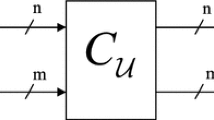Abstract
How to make cloud computing ensure the privacy of data while ensuring its availability in the process of computing data is a big problem faced by cloud computing. Under the background of quantum information processing, a quantum fully homomorphic encryption (QFHE) scheme is proposed. QFHE based on universal quantum circuit (UQC) allows arbitrary quantum transformation. QFHE allows the operation of encrypted data without decryption, which greatly ensures the security of data. In this scheme, the encryption key is constructed by GHZ-like state. Both the encryption key and the decryption key use quantum one-time pad (QOTP), and the decryption key is different from the encryption key. In this scheme, the evaluation algorithm is independent of the encryption key, which is a powerful tool to protect data privacy in the cloud environment. In addition, security analysis and complexity analysis also show that the scheme is suitable for privacy data processing.







Similar content being viewed by others
References
Zongyu, L., Xiaolin, G., Yingjie, G., et al.: Survey on homomorphic encryption algorithm and its application in the privacy-preserving for cloud computing[J]. Journal of Software. 029(007), 1827–1851 (2018)
Ristenpart, T., Tromer, E., Shacham, H., et al.: Hey, you, get off of my cloud: exploring information leakage in third-party compute clouds[C]. ACM conference on computer and communications security. (2009) https://personal.utdallas.edu/~muratk/courses/cloud11f_files/cloudsec.pdf
Ningbo, L., Haonan, Z., Xiaoliang, C., et al.: Design of Directed Decryption Protocol Based on multi key fully homomorphic encryption in cloud environment[J]. Information network security. 20(06), 10–16 (2020)
Karydis I, Sioutas S, Triantafillou P et al. [Lecture Notes in Computer Science] Algorithmic Aspects of Cloud Computing Volume 9511 || SSSDB: Database with Private Information Search[J]. 2016
Riad, K., Ke, L., Andersson, K.: Secure storage and retrieval of IoT data based on private information retrieval[J]. Wirel. Commun. Mob. Comput. 2018, 1–8 (2018)
Wang, X., Luo, T., Li, J.: An Efficient Fully Homomorphic Encryption Scheme for Private Information Retrieval in the Cloud[J]. Int. J. Pattern Recognit. Artif. Intell. 34(04) (2020)
Pasupuleti, S.K., Ramalingam, S., Buyya, R.: An efficient and secure privacy-preserving approach for outsourced data of resource constrained mobile devices in cloud computing. Journal of Network & Computer Applications. 64(C), 12–22 (2016)
Gajek S. Dynamic symmetric searchable encryption from constrained functional encryption. In: Proc. of the Cryptographers’ Track at the RSA Conf. Cham: Springer-Verlag, 2016. 75–89
Chen, Z., Zhang, F., Zhang, P., Zhao, H.: Multi-user Boolean searchable encryption supporting fast ranking in mobile clouds[J]. Comput. Commun. 164, 100–113 (2020)
Ping, Y., Song, W., Zhang, Z., et al.: A Multi-Keyword Searchable Encryption Scheme Based on Probability Trapdoor over Encryption Cloud Data[J]. Information. 11(8) (2020)
Damgard I, Polychroniadou A, Rao V. Adaptively secure multi-party computation from LWE (via equivocal FHE). In: Proc. of the Public-Key Cryptography—PKC 2016. Berlin, Heidelberg: Springer-Verlag, 2016
Rivest, R.L., Shamir, A., Adleman, L.: A method for obtaining digital signatures and public-key cryptosystems. Commun. ACM. 26(2), 96–99 (1978)
Elgamal, T.: A public key cryptosystem and a signature scheme based on discrete logarithms. In: Advances in Cryptology, pp. 469–472. Springer-Verlag, Berlin, Heidelberg (1984)
Boneh, D., Goh, E.J., Nissim, K.: Evaluating 2-DNF Formulas on Ciphertexts. In: Evaluating 2-DNF Formulas on Ciphertexts. Springer, Berlin Heidelberg (2005. http://crypto.stanford.edu/~eujin/papers/2dnf/2dnf.pdf)
Gentry, C., Halevi, S., Vaikuntanathan, V.: A simple BGN-type cryptosystem from LWE[C]. Lect. Notes Comput. Sci. 506–522 (2010)
Vizitiu, A., Puiu, A., Suciu, C., et al.: Applying deep neural networks over homomorphic encrypted medical data. Computational and Mathematical Methods in Medicine. 2020, 1–26 (2020)
Yasuda, M., Shimoyama, T., Kogure, J., et al.: Secure statistical analysis using RLWE-based homomorphic encryption[C]. Lect. Notes Comput. Sci. 9144, 471–487 (2015)
Gentry C. A Fully Homomorphic Encryption Scheme[M]. Stanford University, 2009
Dijk M V, Gentry C, Halevi S et al. Fully Homomorphic Encryption over the Integers[J]. Springer, Berlin, Heidelberg, 2010
Biotechnology - Bioinformatics; Privacy-preserving Genotype Imputation with Fully Homomorphic Encryption[J]. Information Technology Newsweekly,2020
Chen, Z.G.: Research and Design of Fully Homomorphic Encryption based on Lattice [D]. Nanjing: Nanjing University of Aeronautics and Astronautics. 23 (2015)
Srinivas, J., Das, A.K., Kumar, N., et al.: Cloud Centric Authentication for Wearable Healthcare Monitoring System[J]. IEEE Transactions on Dependable and Secure Computing. (99), (2018) 1–1
Gong, C., Du, J., Dong, Z., et al.: Grover Algorithm-based Quantum Homomorphic Encryption Ciphertext Retrieval Scheme in Quantum Cloud Computing[J]. Quantum Inf. Process. 19(3) (2020)
Rivest, R.L., Adleman, L.M., Dertouzos, M.L.: On data banks and privacy Homomorphisms[J]. Foundations of Secure Compuation. 4(11), 169–180 (1978)
Yuanjing, Z., Tao, S., Jianwei, L.: A Multi-valued Quantum Fully Homomorphic Encryption Scheme[J]. Quantum Inf. Process. 20(3) (2021)
Zheng, X.Y., Kuang, C., Liang, W.Z.: Controlled Quantum Dialogue with Authentication Protocol on A Basis of GHZ-like State. Quantum Inf. Process. 19(8) (2020)
Liang, M.: Quantum Fully Homomorphic Encryption Scheme based on Universal Quantum Circuit[J]. Quantum Information Processing. 14(8), 2749–2759
Cabello, A.: Quantum key distribution in the Holevo limit[J]. Phys. Rev. Lett. 85(1), 5635–5638 (2000)
Ye, T.Y., Jiang, L.Z.: Improvement of controlled bidirectional quantum direct communication using a GHZ state[J]. Chin. Phys. Lett. 30(4), 40305–040305 (2013)
He, Y.-F., Ma, W.-P.: Two-party quantum key agreement based on four-particle GHZ states[J]. International Journal of Quantum Information. 14(1), 1650007 (2016) (8 pages)
Hassanpour, S., Houshmand, M.: Efficient Controlled Quantum Secure Direct Communication based on GHZ-like States[J]. Quantum Information Processing. 14(2), 739–753
Acknowledgements
This work was supported by the Liaoning Provincial Natural Science Foundation of China (Grant No. 2019-MS-286), and Basic Scientific Research Project of Liaoning Provincial Department of Education (Grant No. LJC202007).
Author information
Authors and Affiliations
Corresponding author
Additional information
Publisher’s Note
Springer Nature remains neutral with regard to jurisdictional claims in published maps and institutional affiliations.
Rights and permissions
About this article
Cite this article
Zhu, H., Wang, C. & Wang, X. Quantum Fully Homomorphic Encryption Scheme for Cloud Privacy Data Based on Quantum Circuit. Int J Theor Phys 60, 2961–2975 (2021). https://doi.org/10.1007/s10773-021-04879-w
Received:
Accepted:
Published:
Issue Date:
DOI: https://doi.org/10.1007/s10773-021-04879-w




